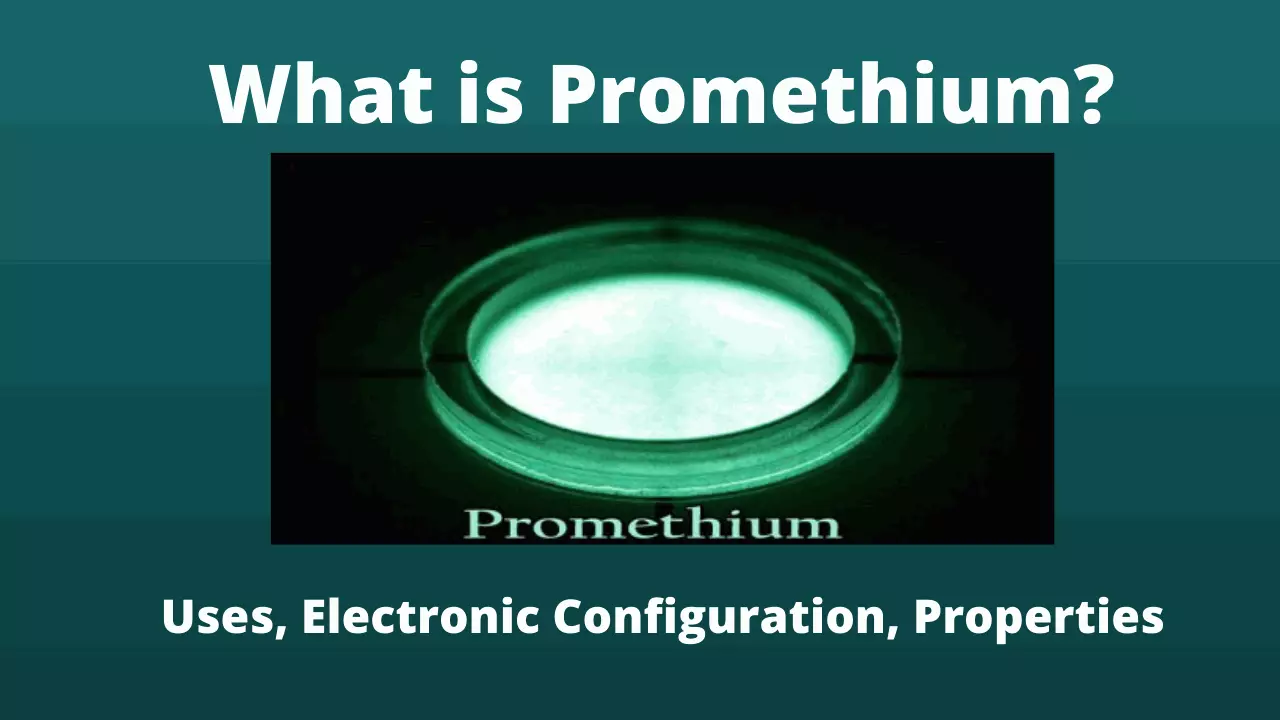
What is Promethium? Electron configuration, Uses, Atomic Number
What is Promethium?
Promethium, Symbol Pm & atomic number 61, a radioactive chemical element of the III group of Mendeleev's periodic table belongs to the lanthanides.
The name of promethium is a reference to the Titan of Greek mythology, Prometheus. This Titan is considered to have stolen fire from the gods and the discovery of this element as a residue in a nuclear reactor gave the idea of this name.
General informations of Promethium |
|
|
Promethium Symbol |
Pm |
|
Atomic number of Promethium |
61 |
|
Family |
Lanthanide |
|
Group |
|
|
Period |
6 |
|
Block |
f |
|
Volumic mass |
7.264 g.cm-3 |
|
Hardness |
|
|
Color |
White |
Atomic properties of Promethium |
|
|
Atomic mass of Promethium |
145 u |
|
Atomic radius |
185 pm |
|
Electronic configuration of Promethium |
[Xe] 4f56s2 |
|
Electrons by energy level |
2 | 8 | 18 | 23 | 8 | 2 |
|
Oxide |
Based |
Physical properties of Promethium |
|
|
Ordinary state |
Solid |
|
Promethium melting point |
1042 ° C |
|
Boiling point |
3000 ° C |
Discovery of promethium
It was 1902 when a Czech chemist, Bohuslav Brauner, realized that there must be an element still unknown during his research on rare earths.
In 1914, it was a British chemist, Henry Moseley who wondered why there is no atomic element with the number 61. He was then one of the first to begin research.
In 1926, two Italian researchers: Luigi Rolla and Lorenzo de Florence Fernandes claimed the discovery of this element 61, following the X-ray spectrum analysis of a sample of didyma. This revealed the presence of a different element of the samarium. They therefore named this element florentium, in honor of the Italian city of Florence.
Almost simultaneously, researchers at the University of Illinois at Urbana-Champaign also published the discovery of element 61. The two scientists behind this discovery, Smith Hopkins and Len Yntema called it illenium in reference to the name of their university.
Unfortunately, it was proven a few years later that these findings were false, promethium having too short a half-life for it to be observed in these sources.
Much later, in 1941, Russian researchers announced the discovery of two isotopes of element 61, which they obtained by bombarding a samarium target with protons. They named this element cyclonium.
However, there is no trace of this discovery: no isolation of the element having been carried out and no spectral analysis having been carried out.
First proven discovery of Promethium
In 1945, researchers at the Oak Ridge National Laboratory in the United States separated and analyzed the fission products of irradiated uranium.
This discovery comes in the midst of research on nuclear weapons, which prompts them not to publish the discovery of element 61 until two years later, in 1947. They thus named it promethium on the proposal of the wife of one.
As earlier researchers believed that they had discovered "the fire of the gods". So the IUPAC, in 1949, named it as promethium after the Greek Titan Prometheus.
Presence of promethium
Promethium is present in traces on our planet Earth but it can also be found in the composition of meteorites that roam in space.
Promethium is present in traces in the earth's crust. These traces result from the alpha decay of two other radioactive elements: europium 151 and uranium 238.
It is also found in uranium ore for a proportion of 4 grams in 10 12 tonnes of pitchblende.
It has also been identified in the spectral lines of several stars.
Electronic configuration of Promethium
The short electronic configuration of the promethium is [Xe] 4f56s2 , remember that the electron configuration shows the way in which the atoms belonging to an element are structured. In detail, promethium electron configuration would be: 1s2 2s2 2p6 3s2 3p6 3d10 4s2 4p6 4d10 5s2 5p6 4f5 5d0 6s2.
The promethium atom and Eu+2 , Gd+3 , Tb+4 have the same electronic configuration.
Promethium has 61 electrons distributed as follows:
- 2 electrons in the first shell.
- 8 electrons in the second shell.
- 18 electrons in the third.
- 23 electrons in the fourth.
- 8 electrons in the fifth.
- 2 electrons in the sixth.
Physical and chemical properties of the element Promethium
- Promethium is a metal that is part of the rare earth family.
- It is also a very radioactive element emitting beta particles.
- However, it does not emit gamma radiation at all.
- There is also metallic promethium but it has characteristics that are still relatively unknown due to a lack of research on it.
- There are also promethium salts which are luminescent in the dark, thanks to their radioactive reactions. The colors that emerge can be green or blue.
Isotopes of Promethium
Promethium has no stable isotope. But there are thirty eight radioisotopes of promethium. Among all these radioisotopes, three are represented in nature:
- Promethium 147,
- Promethium 149,
- Promethium 151.
Its isotope with the longest half-life is promethium-145 which has a half-life of 17.7 years. The one with the smallest half-life is promethium 141 with a half-life of 2 µs.
Uses of element 61
Below are some of the uses of promethium:
- The greatest use of promethium is for its luminescent form.
- It has been used in the past as a thermal generator for NASA as well as in pacemakers.
- A new use of promethium is currently sought for it and its application as a portable X-ray source is under study.
Dangers of promethium
It is important to handle promethium with care, because it can be dangerous. Indeed, the vapors and gases of promethium can cause pulmonary embolism. This risk is all the more increased if the exposure becomes prolonged.
In general, promethium, like other rare earths with comparable properties, accumulates in the liver when absorbed.
What is the atomic mass of promethium?
To know the atomic mass of an element, let you know that it is determined by the total mass that we can find in an element of protons and neutrons. Promethium has an atomic mass of 145u.
What is the atomic radius of promethium?
In the periodic table you can find this element in period 6, block f. Promethium has an atomic radius of 205 Pm; also called Bohr radius. It has an average radius of 185 Pm.
Know about more periodic elements- Gadolinium, Germanium, Neon, Oxygen, Potassium, Promethium, Selenium, Sodium, Terbium, Tellurium, Yttrium, Ytterbium, Zirconium
Related Articales
Recently Posted
-
भगवान गौतम बुद्ध जीवन परिचय | Gautam Buddha in Hindi
December 15, 2022. -
कार्बन के अपररूप Allotropes of Carbon in Hindi
November 5, 2022. -
मिश्र धातु किसे कहते हैं? उपयोग, नाम, गुण Alloy in Hindi
July 27, 2022. -
गलनांक किसे कहते हैं? परिभाषा, उदाहरण Melting Point in Hindi
July 20, 2022. -
परिमाप किसे कहते हैं? Perimeter in Hindi
July 19, 2022.




